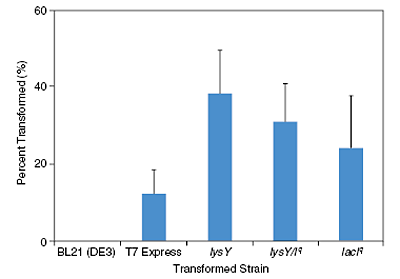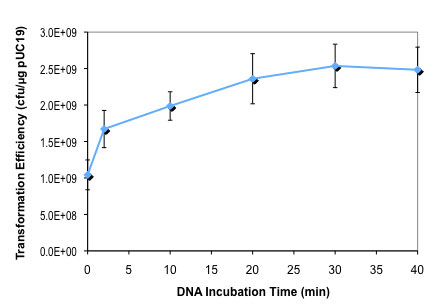T7 Express lysY Competent E. coli (High Efficiency)
Product information| Code | Name | Size | Quantity | Price | |
|---|---|---|---|---|---|
C3010I |
T7 Express lysY Competent E. coli (High Efficiency) |
6 x 0.2 ml | - | Ordering currently unavailable |
6 x 0.2 ml
| - | 1 | + |
T7 Express lysY Competent E. coli (High Efficiency)
Having trouble opening your tubes? NEB Tube Opener can help!
Product Introduction
High efficiency chemically competent E. coli cells suitable for T7 expression with enhanced reduction of basal expression.
- T7 RNA Polymerase in the lac operon - no λ prophage
- Control of T7 RNA Polymerase by lysozyme allows potentially toxic genes to be expressed
- Deficient in proteases Lon and OmpT
- Resistant to phage T1 (fhuA2)
- Free of animal products
- No dry ice surcharge on NEB competent cell shipments
| Catalog # | Size | Concentration |
|---|---|---|
| C3010I | 6 x 0.2 ml |
- Product Information
- Protocols, Manuals & Usage
- Tools & Resources
- FAQs & Troubleshooting
- Citations & Technical Literature
- Quality, Safety & Legal
- Other Products You May Be Interested In
Product Information
Description
Highlights
- Free of animal products
- Control of T7 RNA Polymerase by lysozyme allows potentially toxic genes to be expressed
- LysY is a variant of T7 lysozyme lacking amidase activity, thus cells are less susceptible to lysis during induction
- Maintenance of lysozyme plasmid does not require antibiotic selection
- Enhanced BL21 derivative
- Does not restrict methylated DNA (McrA-, McrBC-, EcoBr-m-, Mrr-)
- Deficient in proteases Lon and OmpT
- Lysozyme for expression control
- T7 RNA Polymerase in the lac operon - no λ prophage
- No Cam requirement
- Fast growth from colonies
- Lysozyme on miniF enhances stability
- Resistant to phage T1 (fhuA2) Cam, Nit
- B Strain
Transformation Efficiency
0.6-1 x 109 cfu/μg pUC19 DNA Enhanced BL21 derivative, chemically competent E. coli cells suitable for high efficiency transformation and protein expression.Genotype
MiniF lysY (CamR) / fhuA2 lacZ::T7 gene1 [lon] ompT gal sulA11 R(mcr-73::miniTn10--TetS)2 [dcm] R(zgb-210::Tn10--TetS) endA1 ∆(mcrC-mrr)114::IS10- This product is related to the following categories:
- T7 Expression,
- E. coli Protein Expression Strains,
- Protein Expression,
- E. coli Expression Strains,
- This product can be used in the following applications:
- T7 Expression,
- Toxic Protein Expression,
- Expression of Difficult Proteins,
- Peptide Ligation,
- Protein Expression in E. Coli, Protein Expression
Reagents Supplied
Reagents Supplied
The following reagents are supplied with this product:
| NEB # | Component Name | Component # | Stored at (°C) | Amount | Concentration | |
|---|---|---|---|---|---|---|
Properties & Usage
Antibiotic for Plasmid Selection
| Antibiotics for Plasmid Selection | Working Concentration |
|---|---|
| Ampicillin | 100 µg/ml |
| Carbenicillin | 100 µg/ml |
| Kanamycin | 30 µg/ml |
| Streptomycin | 25 µg/ml |
| Tetracycline | 15 µg/ml |
Shipping Notes
- Ships on dry ice
Antibiotic Resistance
- nit
- cam
Features
- T7 expression
- Protease deficient
- Better reduction of basal expression
Application Features




Related Products
Companion Products
- T7 Express lysY/Iq Competent E. coli (High Efficiency)
- T7 Express Competent E. coli (High Efficiency)
Materials Sold Separately
Product Notes
- Maintenance of the miniF plasmid does not require antibiotic selection. If chloramphenicol is added, use 10 µg/ml final concentration.
- CAUTION: This product contains DMSO, a hazardous material. Review the MSDS before handling.
- STORAGE AND HANDLING: Competent cells should be stored at -80°C. Storage at -20°C will result in a significant decrease in transformation efficiency. Cells lose efficiency whenever they are warmed above -80°C, even if they do not thaw.
Protocols, Manuals & Usage
Protocols
Usage & Guidelines
Application Notes
Tools & Resources
Selection Charts
FAQs & Troubleshooting
FAQs
- Why are there no colonies or no growth in liquid culture (C3010)?
- Why is there no protein visible on gel or no activity (C3010)?
- Why is induced protein insoluble (C3010)?
- What are the solutions/recipes (C3010)?
- What are the strain properties (C3010)?
- Can I store competent cells at -20°C instead of -80°C?
- What is the difference between NEB #C3010H and NEB #C3010I?
- What is the optimal heat shock time for this strain (NEB #C3010H and NEB #C3010I)?
- How long should I incubate cells on ice after DNA has been added (NEB #C3010H and NEB #C3010I)?
- Is T7 Express lysY (NEB #C3010H and NEB #C3010I) compatible with auto-induction procedures?
- Which kind of transformation tubes should be used?
- What volume of DNA can be added into competent cells?
- What s the shelf life for this strain (NEB #C3010H and NEB #C3010I)?
- Are NEB's competent cells compatible with the “Mix & Go" protocol?
- Is antibiotic selection necessary to maintain the MiniF-lysY plasmid?
- Is T7 expression subject to catabolite repression in NEB T7 Express or SHuffle strains?
Citations & Technical Literature
Citations
Additional Citations
Quality, Safety & Legal
Quality Assurance Statement
Quality Control tests are performed on each new lot of NEB product to meet the specifications designated for it. Specifications and individual lot data from the tests that are performed for this particular product can be found and downloaded on the Product Specification Sheet, Certificate of Analysis, data card or product manual. Further information regarding NEB product quality can be found here.Specifications
The Specification sheet is a document that includes the storage temperature, shelf life and the specifications designated for the product. The following file naming structure is used to name these document files: [Product Number]_[Size]_[Version]Certificate Of Analysis
The Certificate of Analysis (COA) is a signed document that includes the storage temperature, expiration date and quality controls for an individual lot. The following file naming structure is used to name these document files: [Product Number]_[Size]_[Version]_[Lot Number]- C3010I_v1_0071604
- C3010I_v1_0071607
- C3010I_v1_0071611
- C3010I_v1_0071612
- C3010I_v1_0071703
- C3010I_v1_0071704
- C3010I_v1_0071707
- C3010I_v1_0081711
- C3010I_v1_0081801
- C3010I_v1_10015843
- C3010I_v1_10023177
- C3010I_v1_10030706
- C3010I_v1_10034755
- C3010I_v1_10040630
- C3010I_v1_10047021
- C3010I_v1_10047077
- C3010I_v1_10049563
- C3010I_v1_10054347
- C3010I_v1_10057766
- C3010I_v1_10061457
- C3010I_v1_10063272
- C3010I_v1_10068782
- C3010I_v1_10071378
- C3010I_v1_10076861
- C3010I_v1_10079074
- C3010I_v1_10081772
- C3010I_v1_10084669
- C3010I_v1_10087562
- C3010I_v1_10097563
- C3010I_v1_10103372
- C3010I_v1_10105822
- C3010I_v1_10113641
- C3010I_v1_10118471
- C3010I_v1_10123917
- C3010I_v1_10131376
- C3010I_v1_10140757
- C3010I_v1_10147721
- C3010I_v1_10154511
- C3010I_v1_10160597
- C3010I_v1_10161125
- C3010I_v1_10163720
- C3010I_v1_10170222
- C3010I_v1_10178637
- C3010I_v1_10181261
- C3010I_v1_10193284
- C3010I_v1_10204929
- C3010I_v1_10213244
- C3010I_v1_10222737
- C3010I_v1_10229431
- C3010I_v1_10237574
- C3010I_v1_10245004
- C3010I_v1_10254824
- C3010I_v1_10264010
- C3010I_v1_10273281
- C3010I_v1_10280470
- C3010I_v1_10287380
- C3010I_v1_10290870
- C3010I_v1_10301443
- C3010I_v1_10307304
Safety DataSheets
The following is a list of Safety Data Sheet (SDS) that apply to this product to help you use it safely.T7 Express lysY Competent E. coli (High Efficiency)
Legal and Disclaimers
Products and content are covered by one or more patents, trademarks and/or copyrights owned or controlled by New England Biolabs, Inc (NEB). The use of trademark symbols does not necessarily indicate that the name is trademarked in the country where it is being read; it indicates where the content was originally developed. The use of this product may require the buyer to obtain additional third-party intellectual property rights for certain applications. For more information, please email busdev@neb.com.This product is intended for research purposes only. This product is not intended to be used for therapeutic or diagnostic purposes in humans or animals.
New England Biolabs (NEB) is committed to practicing ethical science – we believe it is our job as researchers to ask the important questions that when answered will help preserve our quality of life and the world that we live in. However, this research should always be done in safe and ethical manner. Learn more.
Other Products You May Be Interested In
The supporting documents available for this product can be downloaded below.

